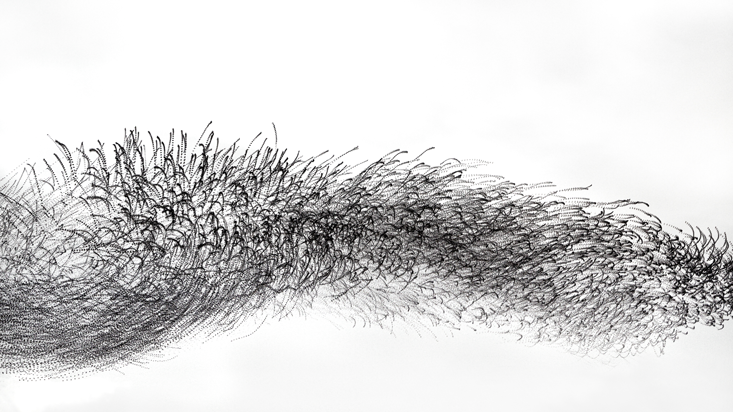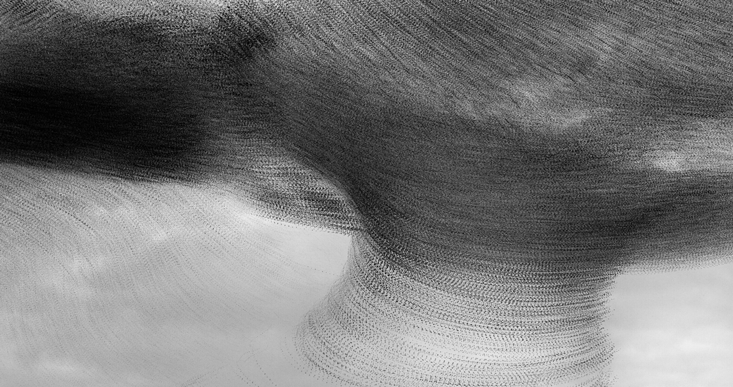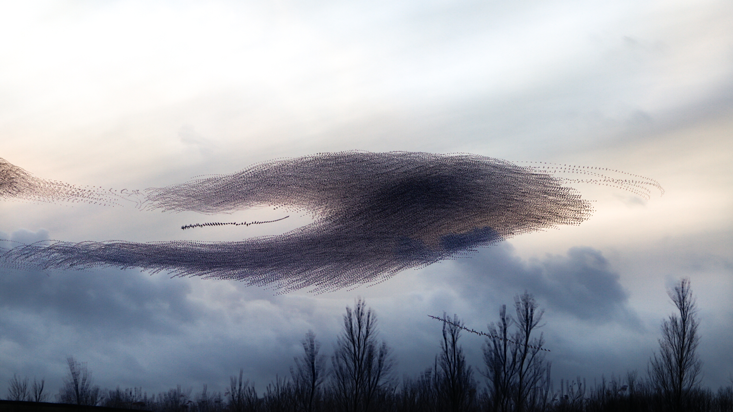At first, they trickle in: one bird here, a few birds there. Then, at dusk’s cue, a dark smudge materializes on the horizon. Thousands of starlings (Sturnus vulgaris) slowly come into focus, etching flight paths across the winter sky as they stream toward their evening roost in north-central England. Suddenly, the flock dips and twists like a horse tossing its head. It swirls into a funnel, then cartwheels to the side, shapeshifting in seemingly effortless unison. All the while, the birds’ feverish wingbeats and raucous chatter reverberate through the air—and reveal why this intricately coordinated performance earned its name: a murmuration.
Each winter, starlings gather in large flocks of up to 100,000 individuals across the United Kingdom. Most have migrated from northern Europe seeking milder temperatures and more abundant food. Their arrival is celebrated by residents outside the city of Sheffield, England where restored wetlands offer prime roost habitat, and where vast horizons make a perfect theater for evening murmurations. Among the routine spectators is Kathryn Cooper, a physicist-turned-photographer who sees more than just a mesmerizing aerial display. Trained in bioinformatics, Cooper has a keen eye for understanding complex data. “I’m interested in the transient moments when chaos briefly changes to order, and thousands of individual bodies appear to move as one,” she says.

Cooper has endured more than 50 cold and wind-whipped evenings in patient pursuit of such fleeting moments. Over the last four years, she’s also refined a modern approach to a 19th-century technique called chronophotography: assembling a sequence of images to study motion. To illustrate a particular piece of murmuration choreography, Cooper first films the starlings in 4K resolution. Then, working with clips that range in length from less than a second to more than a minute, she designs algorithms that help her select and splice together a compelling set of frames. “It’s really fascinating to be visualizing [the murmuration] at the same time that people are researching it,” she says.
While murmurations are a well-documented phenomenon, scientists are still working to understand why they occur. One hypothesis suggests that starlings murmurate to advertise the evening’s roost to stragglers, since bigger roosts offer more warmth. But a 2017 study found that predation pressure is a more powerful driver; in a sample of more than 3,000 murmurations, the presence of predators was positively correlated with both murmuration size and duration. Large flocks don’t just benefit from increased vigilance. Their complex flight patterns also prevent predators from honing in on a singular target, increasing the odds of survival for each starling in the flock.
Despite their seeming ubiquity, starling populations have declined in the United Kingdom by approximately 70 percent since 1980 due to the loss of suitable roosting and feeding grounds, including wetlands and meadows. But habitat restoration projects are helping to reverse that trend. The nature reserves where Cooper captured these images were once home to coal mines and quarries, their only soundtrack the rumbling of trucks and mining machinery. Today, these restored wetlands sing with the buzzing of bees and beetles, the mating calls of bitterns and other wading birds, and, each winter, the hum of murmurations as starlings dance across the skies.

Cooper’s photographs, captured over the course of four winters, reveal the movements of murmurations in north-central England—congregations of starlings that are sometimes dense enough to blacken the sky.

“It’s a wonderful and absorbing experience, with thousands of chattering birds surging just meters above you,” she says.

As dusk approaches, birds pour from their daytime perches—in this case atop transmission towers and power lines—to join the murmuration.

The murmuration, which moves like a billowing curtain of smoke, likely confuses predators, preventing them from singling out an individual target.

But not all birds of prey are deterred by the immense spectacle. Here, hungry sparrowhawks (Accipiter nisus) plunge into the swirling mass for their next meal.

With each swoop of the sparrowhawk, the starlings scatter.

The flock swirls like a tornado as the attacks continue, and the starlings desperately seek a suitable place to land.

Inside the flock, individual birds react to the movements of those immediately around them. This photograph—created from just over a second of video footage—reveals the flight paths of birds in the middle of the flock as they twist and turn.

Sometimes predators work in teams to improve their odds of success. Here, one sparrowhawk splits the flock while another attacks from below to keep the starlings from descending into the safety of the reed beds.

When predators are present, the starlings make a beeline for the vegetation as quickly as possible.

But not every dusk commute is rushed. When predators are scarce, starlings sometimes arrive at their roost site in small groups, casually perusing the reed bed in search of the best landing spot.

On these occasions, the birds descend in orderly stages. The first to settle in are sometimes disturbed by new arrivals, and some birds burst skyward. But eventually, they all claim a roosting reed.

The starlings are somewhat predictable, but not always—a lesson Cooper takes to heart. One night, when the flock had seemingly settled elsewhere, Cooper fixed her eyes on the horizon. Out of nowhere, the murmuration returned, and the performance began once again—just as dazzling as the evening before.
Katie Jewett is a science writer at the California Academy of Sciences, where she loves learning something new about our planet every day. Previously, she spent winters in the Colorado Rockies and summers living and working on the water.
Kathryn Cooper is a photographer and scientist interested in capturing the beauty of complex natural systems. For her, it’s the perfect opportunity to combine a love for the outdoors with an academic background in physics and network science. Cooper lives in Yorkshire, United Kingdom, which is within easy striking distance to the region’s stunning national parks. You can see more of her work at kathryncooperwildlife.com.
This story originally appeared in bioGraphic, an online magazine about nature and solutions powered by the California Academy of Sciences.


























